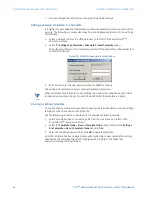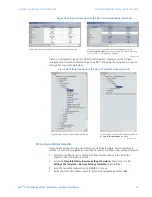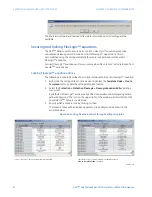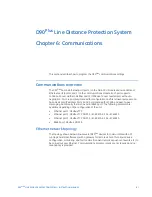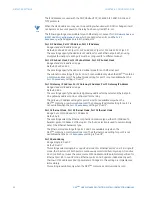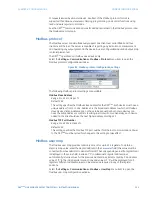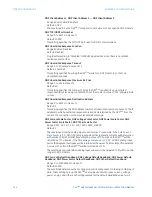
CHAPTER 6: COMMUNICATIONS
NETWORK SETTINGS
D90
PLUS
LINE DISTANCE PROTECTION SYSTEM – INSTRUCTION MANUAL
93
OSI Network Address (NSAP)
Range: 20 alphanumeric characters
Default: 00 00 00 00 00 00 00 00 00 00 00 00 00 00 00 00 49 00 00 00
This setting specifies the NSAP address used with the IEC 61850 protocol over the OSI
(CLNP/TP4) stack.
ESH Configuration Timer
Range: 0 to 32767 seconds in steps of 1
Default: 120 seconds
The End System to Intermediate System Routing Exchange protocol used with ISO 8473
mandates that the end system construct and transmit an End System Hello (ESH) signal
for each NSAP it serves, based on an internal timer. This setting specifies the
transmission time for the ESH signal. This setting takes affect when the D90
Plus
is
rebooted.
The following command is also available from this window.
Configure IP Network
This command validates the IP address, subnet mask, and gateway IP address settings
for all ports. If the validation is successful, then the
Configure IP Network Status
value
will be “OK” and the new settings will take effect immediately. If the validation fails, then
the
Configure IP Network Status
value will indicate the reason for failure and the
network settings will be restored to their previous values.
The following actual values are also available from this window.
Configure IP Network Status
Range: OK, PORT 1 NETMASK ERROR, PORT 2 NETMASK ERROR, PORT 3 NETMASK ERROR,
PORT 1 IP ADDR RSVD, PORT 2 IP ADDR RSVD, PORT 3 IP ADDR RSVD, PORT 1 IP ADDR
LPBK, PORT 2 IP ADDR LPBK, PORT 3 IP ADDR LPBK, PORT 1 IP ADDR NETWK, PORT 2 IP
ADDR NETWK, PORT 3 IP ADDR NETWK, PRT 1-2 SUBNET OVRLP, PRT 1-3 SUBNET OVRLP,
PRT 2-3 SUBNET OVRLP, >1 GATEWAY DEFINED
This actual value displays the status of the
Configure IP Network
command. The
following status values are indicated.
–
“OK”: All supplied user IP parameters are valid and have been applied to the
network stack.
–
“PORT 1 NETMASK ERROR”, “PORT 2 NETMASK ERROR”, “PORT 3 NETMASK ERROR”:
An invalid network mask value was entered for Ethernet port 1, 2, or 3,
respectively.
–
“PORT 1 IP ADDR RSVD”, “PORT 2 IP ADDR RSVD”, “PORT 3 IP ADDR RSVD”: A
reserved IP address was entered for Ethernet port 1, 2, or 3, respectively. Reserved
IP addresses include 0.---.---.--- (for self-identification), 224.---.---.--- through
239.---.---.--- (multicast), and 240.---.---.--- through 255.---.---.--- (reserved by
IANA).
–
“PORT 1 IP ADDR LPBK”, “PORT 2 IP ADDR LPBK”, “PORT 3 IP ADDR LPBK”: A
loopback IP address was entered for Ethernet port 1, 2, or 3, respectively.
–
“PORT 1 IP ADDR NETWK”, “PORT 2 IP ADDR NETWK”, “PORT 3 IP ADDR NETWK”:
The entered IP address is the network address for Ethernet port 1, 2, or 3,
respectively.
–
“PRT 1-2 SUBNET OVRLP”: The entered network parameters for Ethernet port 1
overlap the network parameters for Ethernet port 2.
–
“PRT 1-3 SUBNET OVRLP”: The entered network parameters for Ethernet port 1
overlap the network parameters for Ethernet port 3.
–
“PRT 2-3 SUBNET OVRLP”: The entered network parameters for Ethernet port 2
overlap the network parameters for Ethernet port 3.


